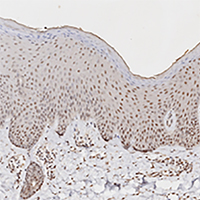MicroRNA-17-3p is upregulated in psoriasis and regulates keratinocyte hyperproliferation and pro-inflammatory cytokine secretion by targeting CTR9

Submitted: 18 May 2021
Accepted: 31 December 2021
Published: 12 January 2022
Accepted: 31 December 2021
Abstract Views: 1408
PDF: 591
Supplementary: 109
HTML: 25
Supplementary: 109
HTML: 25
Publisher's note
All claims expressed in this article are solely those of the authors and do not necessarily represent those of their affiliated organizations, or those of the publisher, the editors and the reviewers. Any product that may be evaluated in this article or claim that may be made by its manufacturer is not guaranteed or endorsed by the publisher.
All claims expressed in this article are solely those of the authors and do not necessarily represent those of their affiliated organizations, or those of the publisher, the editors and the reviewers. Any product that may be evaluated in this article or claim that may be made by its manufacturer is not guaranteed or endorsed by the publisher.
Similar Articles
- S. Zara, V. Macchi, R. De Caro, M. Rapino, A. Cataldi, A. Porzionato, pPKCα mediated-HIF-1α activation related to the morphological modifications occurring in neonatal myocardial tissue in response to severe and mild hyperoxia , European Journal of Histochemistry: Vol. 56 No. 1 (2012)
- AI Scovassi, A Torriglia, Activation of DNA-degrading enzymes during apoptosis , European Journal of Histochemistry: Vol. 47 No. 3 (2003)
- Vanessa Dela Justina, Sebastian San Martin, Daniela López-Espíndola, Alecsander F. M. Bressan, Raiany Alves de Freitas, Ana Maria Lopes de Passos, Juan Varas, Victor V. Lima, Fernanda R. Giachini, Increased expression of STAT3 and SOCS3 in placenta from hyperglycemic rats , European Journal of Histochemistry: Vol. 63 No. 4 (2019)
- L Postiglione, G Di Domenico, L Ramaglia, AE di Lauro, F Di Meglio, S Montagnani, Different titanium surfaces modulate the bone phenotype of SaOS-2 osteoblast-like cells , European Journal of Histochemistry: Vol. 48 No. 3 (2004)
- ML Rossi, N Marziliano, PA Merlini, E Bramucci, U Canosi, P Presbitero, E Arbustinie, PM Mannucci, D Ardissino, Phenotype commitment in vascular smooth muscle cells derived from coronary atherosclerotic plaques: differential gene expression of endothelial Nitric Oxide Synthase , European Journal of Histochemistry: Vol. 49 No. 1 (2005)
- C Foglieni, S Scabini, D Belloni, F Broccolo, P Lusso, MS Malnati, E Ferrero, Productive infection of HUVEC by HHV-8 is associated with changes compatible with angiogenic transformation , European Journal of Histochemistry: Vol. 49 No. 3 (2005)
- Carlo Alberto Redi, RNA therapeutics - Function, design and delivery , European Journal of Histochemistry: Vol. 55 No. 2 (2011)
- S. Lomoio, D. Necchi, E. Scherini, Uneven distribution of NG2 cells in the rat cerebellar vermis and changes in aging , European Journal of Histochemistry: Vol. 56 No. 3 (2012)
- Arianna Casini, Rosa Vaccaro, Mattia Toni, Carla Cioni, Distribution of choline acetyltransferase (ChAT) immunoreactivity in the brain of the teleost Cyprinus carpio , European Journal of Histochemistry: Vol. 62 No. 3 (2018)
- S Fakan, Ultrastructural cytochemical analyses of nuclear functional architecture , European Journal of Histochemistry: Vol. 48 No. 1 (2004)
<< < 68 69 70 71 72 73 74 75 76 77 > >>
You may also start an advanced similarity search for this article.

 https://doi.org/10.4081/ejh.2022.3275
https://doi.org/10.4081/ejh.2022.3275











